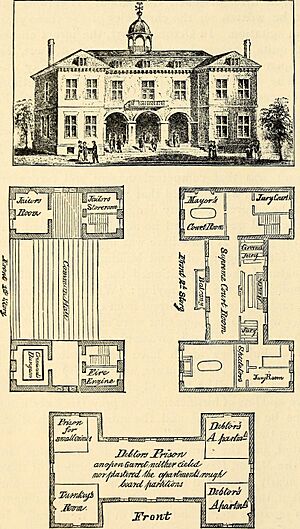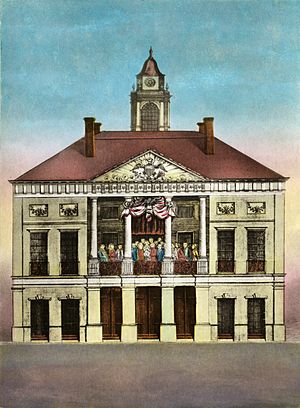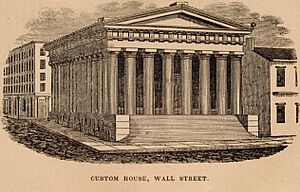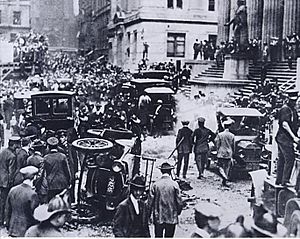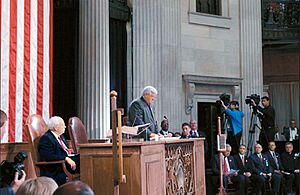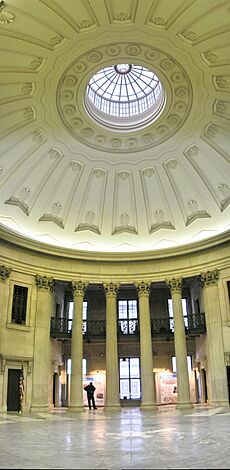Federal Hall facts for kids
|
Federal Hall National Memorial
|
|
|
U.S. Historic district
Contributing property |
|

A view of Federal Hall National Memorial in 2019
|
|
| Location | 26 Wall Street Manhattan, New York, U.S. |
|---|---|
| Area | 17,200 square feet (1,600 m2) |
| Built | 1842 |
| Architect | Town and Davis; John Frazee (Interior Rotunda) |
| Architectural style | Greek Revival |
| Visitation | 63,314 (2024) |
| Website | Federal Hall National Memorial |
| Part of | Wall Street Historic District (ID07000063) |
| NRHP reference No. | 66000095 |
Quick facts for kids Significant dates |
|
| Added to NRHP | October 15, 1966 |
| Designated NMEM | August 11, 1955 |
| Designated CP | February 20, 2007 |
Federal Hall was the first capitol building of the United States under the Constitution. It was where the First United States Congress met and where George Washington had his first inauguration as president. The original building stood on Wall Street in New York City from 1703 until it was torn down in 1812.
Today, the site is home to the Federal Hall National Memorial. This beautiful Greek Revival building was finished in 1842. It was first used as a U.S. Custom House, where taxes on goods from other countries were collected. Later, it became a Subtreasury, a place where the government stored money.
The National Park Service now runs the building as a museum. It honors the important events that happened at the original Federal Hall. The memorial is a famous landmark in the Financial District of Manhattan.
Contents
The First Building: A Center of History
The first building on this spot was New York's second city hall, built between 1699 and 1703. It was a very important place even before the United States was a country.
New York's City Hall
The original City Hall was a two-story building made with stones from the old city wall. It had a public library and a firehouse. The upper floors were used as a jail for people who owed money.
In 1735, a famous trial happened here involving a newspaper publisher named John Peter Zenger. He was arrested for writing things that criticized the British royal governor. He was found not guilty because what he wrote was true. This case became a major step toward establishing freedom of the press in America.
Later, in 1765, leaders from nine of the Thirteen Colonies met here for the Stamp Act Congress. They protested a new tax from Great Britain, arguing against "taxation without representation." This was one of the first times the colonies worked together to oppose British rule.
America's First Capitol
After the American Revolution, City Hall became the home of the Congress of the Confederation, the first government of the United States. New York City wanted to be the nation's capital. The city and its citizens spent $65,000 to turn City Hall into a proper capitol building.
A French architect named Pierre Charles L'Enfant was chosen to redesign the building. He added a grand balcony with large columns and a carving of an American eagle. The building was renamed Federal Hall.
On March 4, 1789, the 1st Congress met at Federal Hall. A month later, on April 30, George Washington stood on the balcony and took the oath of office to become the first president.
Many important laws were passed here. The United States Bill of Rights was proposed at Federal Hall. The Judiciary Act of 1789 was also passed, which created the federal court system that we still have today.
In 1790, the U.S. capital moved to Philadelphia. Federal Hall was used for state government offices until it was torn down in 1812. A part of the original balcony where Washington was inaugurated is now on display inside the memorial.
The Second Building: A Grand Structure
The current building on the site was built to be a U.S. Custom House. This is where the government collected taxes on goods brought into the country.
U.S. Custom House
The new building was designed by famous architects Ithiel Town and Alexander Jackson Davis. They designed it in the Greek Revival style, which was very popular at the time. The style was meant to look like the ancient temples of Greece and Rome, symbols of democracy and republic.
Construction began in 1834 and was finished in 1842. The building is made of beautiful white marble. Its most famous features are the huge Doric columns at the front and a large domed room, called a rotunda, inside.
The Custom House was very busy. But by the 1860s, it was too small for all the trade coming through New York. The customs offices moved to a larger building on Wall Street in 1862.
U.S. Subtreasury
After the Custom House moved out, the building became a United States Subtreasury. It was one of six in the country where the U.S. government stored its money. The building's basement had strong vaults to hold gold and silver. At one point, it held 70% of all the money owned by the federal government.
In 1883, a bronze statue of George Washington was placed on the front steps. It stands at the same height as the balcony of the original Federal Hall, where Washington took his oath of office.
In 1920, a bomb exploded across the street. The event was known as the Wall Street bombing. Many people were hurt, but the strong Subtreasury building was not damaged. The Subtreasury system was replaced by the Federal Reserve Bank in 1920, and the building was used for other government offices.
Becoming a National Memorial
In the 1930s, there were plans to tear down the Subtreasury building. A group called Federal Hall Memorial Associates raised money to save it.
A Historic Site
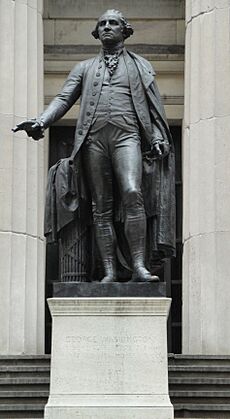
On May 26, 1939, the building was named the Federal Hall Memorial National Historic Site. The National Park Service (NPS) took over and turned it into a museum. The memorial honors the original Federal Hall and the important events that happened there.
The building officially opened as a museum on Washington's Birthday, February 22, 1940. Over the years, it has been a place for many public events, from patriotic rallies to historical celebrations.
In 1955, it was renamed a national memorial. The building's exterior and parts of its interior are protected as New York City designated landmarks.
Recent History
During the September 11, 2001, attacks, about 300 people took shelter inside Federal Hall. The building was closed for a month for safety checks.
On September 6, 2002, members of Congress met at Federal Hall. It was the first time Congress had met in New York since 1790. This was done to show support for the city after the attacks.
The building closed in 2004 for a $16 million renovation to repair its foundation and reopened in 2006. In 2021, the memorial was temporarily closed again after cracks were found in the stone. A major repair project is planned to make sure the building is safe for future generations.
Architecture and Design
Federal Hall National Memorial is a masterpiece of Greek Revival design. The architects wanted to create a building that represented American ideals.
The front of the building has 18 granite steps leading up to a porch with eight massive Doric columns. These columns look like those on the Parthenon in Greece, honoring the idea of democracy.
Inside, the main feature is the rotunda, a large circular room that is 60 feet across. The rotunda is topped by a beautiful dome with a skylight. The design of the dome was inspired by the Pantheon in Rome and honors the ideals of the Roman Republic. The floor is made of gray and cream marble tiles arranged in circles.
Visiting Federal Hall
Federal Hall is operated by the National Park Service and is usually open to the public on weekdays. Admission is free. Inside, you can find exhibits about George Washington's inauguration, the Bill of Rights, and New York's time as the nation's capital.
One of the most important items on display is the Bible that George Washington used to swear his oath of office. You can also see a piece of the original balcony from the first Federal Hall. The memorial offers guided tours and has a gift shop.
Images for kids
-
A painting by Archibald Robertson from around 1798, showing Federal Hall and Trinity Church.
-
Federal Hall as seen from the New York Stock Exchange Building.
-
A 1957 postage stamp featuring Alexander Hamilton and Federal Hall.
See also
 In Spanish: Federal Hall para niños
In Spanish: Federal Hall para niños


